I received calligraphy works carefully created by Mr. Tang Kaizhi, PhD from the China Academy of Art and postdoctoral fellow at Capital Normal University, for the dissemination and promotion of the "Cuan Culture" in Qujing, Yunnan Province. I was grateful and felt uneasy. I took up my pen several times to write some appreciation of his works. When I checked the information on the Internet over and over again and saw many scholars and famous masters praising him for their exquisite comments on his calligraphy works, I knew that my knowledge was shallow and I could only study hard. There was no better language that could describe Tang Kaili. The expression of Mr. and his works is expressive. But I can’t help but want to show his calligraphy works for everyone to appreciate and comment as soon as possible. The beauty and beauty are shared. Let’s give some personal learning experience and appreciation of these calligraphy works!
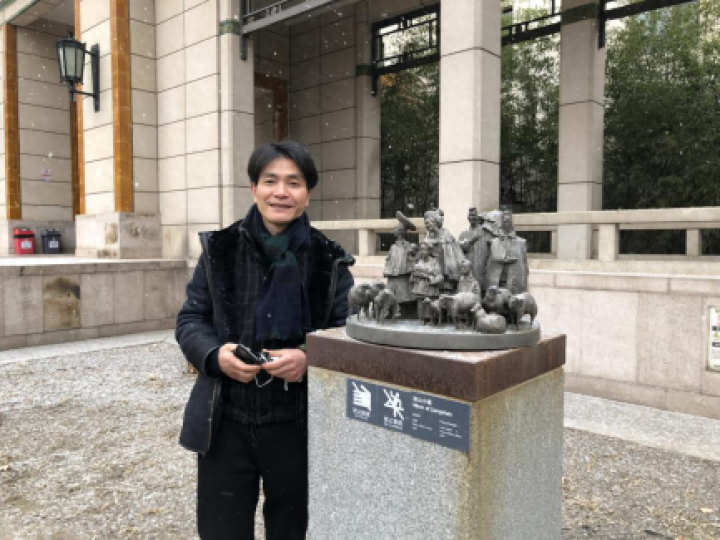
△Tang Kaizhi, born in 1971 in Guilin, Guangxi, is a professor and doctoral supervisor at the Shanghai Academy of Fine Arts, Shanghai University.
Looking at the personal profile of Mr. Tang Kaizhi, it is not difficult to find that his mentors on the path of studying calligraphy and painting art are all well-known teachers in the academic circle of calligraphy today, including a doctorate from the China Academy of Art (Professor Wang Dongling), a postdoctoral fellow from Capital Normal University (Ouyang Zhongshi), a visiting scholar at Peking University (supervised by Professor Zhu Qingsheng), and a member of the Shen Peng calligraphy elite class of the China National Academy of Painting. He was born in 1971 in Guilin, Guangxi. He currently teaches at the Shanghai Academy of Fine Arts, Shanghai University, as a professor and doctoral supervisor. Member of the Chinese Calligraphers Association, deputy director of the Cursive Script Professional Committee of the Shanghai Calligraphers Association. His calligraphy and seal cutting works have been selected into national art exhibitions for many times, and he mainly participated in 4 communication and promotion projects of the National Art Fund. He serves as the editor-in-chief of the calligraphy volume of "The Complete Collection of Lin Sanzhi's Calligraphy", the deputy editor-in-chief of "The Complete Collection of Bronze Inscriptions in the National Library", and the editor-in-chief of the textbook "Cursive Script Copying and Creation". Published collections of works "New Book of Tang Dynasty" and "Xiangwai", and monograph "Live Scene: Innovative Characteristics of Modern Calligraphy Education at China Academy of Art", etc.
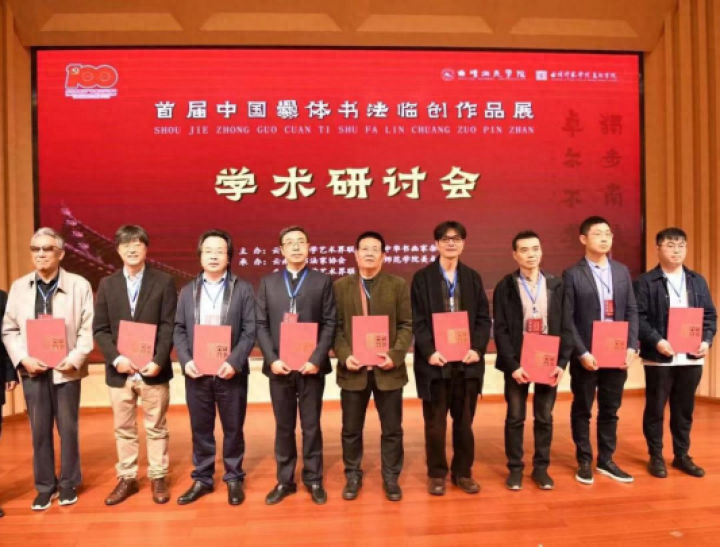
△From left: Zhao Haoru, Zhang Gongzhe, Liu Zongchao, Li Yifeng, Meng Qingxing, Tang Kaizhi, Chang Hanping, Mei Yuehui, Wang Qingmin
Mr. Tang Kaizhi and I first met at the first academic seminar on the Chinese Cuan style calligraphy temporary creation exhibition held at Yunnan Qujing Normal University in April 2021. 47 experts and scholars from all over the country gathered together. This was the first national academic seminar on Cuan style calligraphy held in the form of a work exhibition and seminar. At the meeting, more than ten experts and scholars, including Zhang Gongzhe, Liu Zongchao, Meng Qingxing, Li Yifeng, Cheng Lianfang, Zhao Haoru, and Tang Kaizhi, concluded that "Cuan Baozi Stele" and "Cuan Longyan Stele" are the fusion of official script and regular script. Another calligraphy font for one - "fitting", to the modern "Er Cuan" method, we talked about several issues in the study of stele inscriptions, as well as the artistic spirit of "Er Cuan" calligraphy, the aesthetic value of "Er Cuan" and other aspects of the exchange and expounded their respective latest academic Research results.

Among them, Tang Kaizhi took the title "Reflection and Construction of "Cuan Aesthetics"" to examine the aesthetic core of Er Cuan Monument from a philosophical perspective, and creatively proposed the concept of "Cuan Aesthetics" for the first time. Tang Kaizhi proposed that the "Er Cuan" stele has been famous since the Qing Dynasty. It has attracted worldwide attention because of its outstanding and ancient artistic features and its location in a territory rich in national characteristics. According to historical records, the Southern Dynasties followed the old system of the Eastern Jin Dynasty and prohibited the erection of private steles, so the number of surviving steles is very small. The "Er Cuan" stele located on the border of Yunnan is extremely precious. The culture of Yunnan stele inscriptions during the Six Dynasties period has a high degree of aesthetic convergence with the calligraphy style of stele inscriptions and calligraphy in the Central Plains. The stone inscriptions and calligraphy in the history of calligraphy inject a unique aesthetic core into the "Er Cuan" stele. In the Qing Dynasty, "steleology" flourished. Kang Nanhai listed "Cuan Longyan Stele" as "the first divine product" and "Cuan Baozi Stele" as "the originator of true calligraphy". Therefore, Cuan Stele integrated into the continuous development of Steleology in the Qing Dynasty and was widely worshiped and studied by calligraphers and scholars, forming an aesthetic system that continued the "Steleology" in the Qing Dynasty. The exploration of the calligraphy aesthetics of the "Er Cuan" stele is based on the objective examination of the development of the "Cuan stele" and is the prerequisite for constructing the unique aesthetic form of the "Cuan aesthetics". On this basis, the wild formal meaning of "Cuan Longyan Stele" is summarized as "natural without carving", and its aesthetic conception is "wild", "super-achieved" and "robust"; "Cuan Baozi Stele" is original and brutal Its style and spirit are "literary, natural, and full of gestures", and its aesthetic conception is "ancient", "qingqi" and "beautiful".
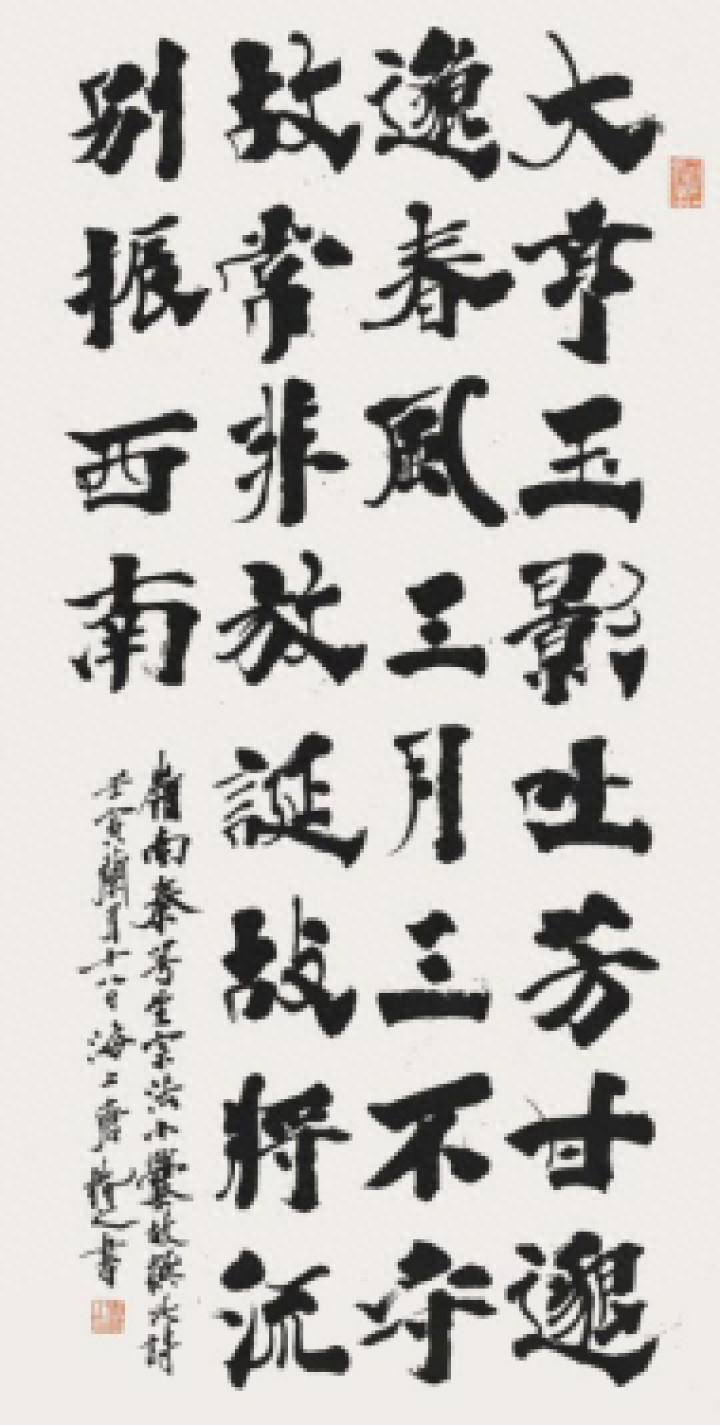
△ "The jade shadow of the tycoon spits sweet fragrance, and the spring breeze of Miao Miao is March 3rd. It is very unruly to not keep the old tradition, so I will leave and shake the southwest." Xiao Cuan, the descendant of the Qin family in Lingnan, wrote this poem on the 18th day of Renyin Lan Yue, Tang Kaikai on the sea. The book is 69×138cm.
Tang Kaizhi's pursuit of calligraphy art originated from his heart and penetrated deep into his soul. By reading his calligraphy works and writings, you can deeply feel his awe and love for traditional cultural classics. The pinnacle of Tang Kaishu and Tang poetry are a pair of dazzling wonders of ancient Chinese literature and art. Coincidentally, the name "Tang Kaizhi" is related to him, and it seems that he is destined to pursue a career in calligraphy. Tang Kai is a collection of regular script from the Wei, Jin, Southern and Northern Dynasties, forming a solemn and dignified font, stable and dignified strokes, rigorous structure, and strict laws. The regular script work "Qin Jisheng's Poems Praising Cuan Bao" written by Tang Kaizhi is thick, full and broad, and contains the Tang Kai Kungfu that is vigorous, dignified and advocating the law. The seal script work "Han Tianheng's Poetry in Praise of Cuan Baozi Stele" written by Tang Kaizhi adopts the small seal style of the Qin and Han Dynasties, and the strokes blend into the large seal script's ancient clumsiness and cursive style, showing the green, desolate, simple and straightforward, ancient and indifferent atmosphere.

△ "There is a lack of ancient books in southern Yunnan, and if there are books, they will come out strangely. If you read Cuan Baozi, Xi Zhi will sigh." Mr. Han Tianheng's poem praising "Cuan Baozi Monument" on the 19th day of the Renyin Lan month in Tang Kai in Langhua 34.5 ×138cm.
Cursive script is the most expressive of emotions, but it also requires the most technical skills and is the most difficult to create. It just so happens that cursive script is the calligraphy style that Tang Kaizhi is best at. His works such as "Kang Youwei's Poems Praising Cuan Longyan Stele" and "Tang Wang Zhihuan's Poems Ascending the Stork Tower" are written with ease and freehand, full of fast and slow rhythms and dark and light rhythms, with soft lines. With rigidity, both square and round. The spacing within the lines and the thickness of the characters transition naturally, and the connection is delicate and subtle. While paying attention to the techniques, it integrates its own true temperament, which is eloquent, unrestrained, and natural. The work shows the author's frankness and agility, a new look of calligraphy that comes from ancient times, and tells the author's spiritual trajectory. The work is atmospheric, vivid and ethereal, floating like floating clouds like a splash-ink landscape painting, giving people a strong visual impression and artistic quality. of enlightenment.
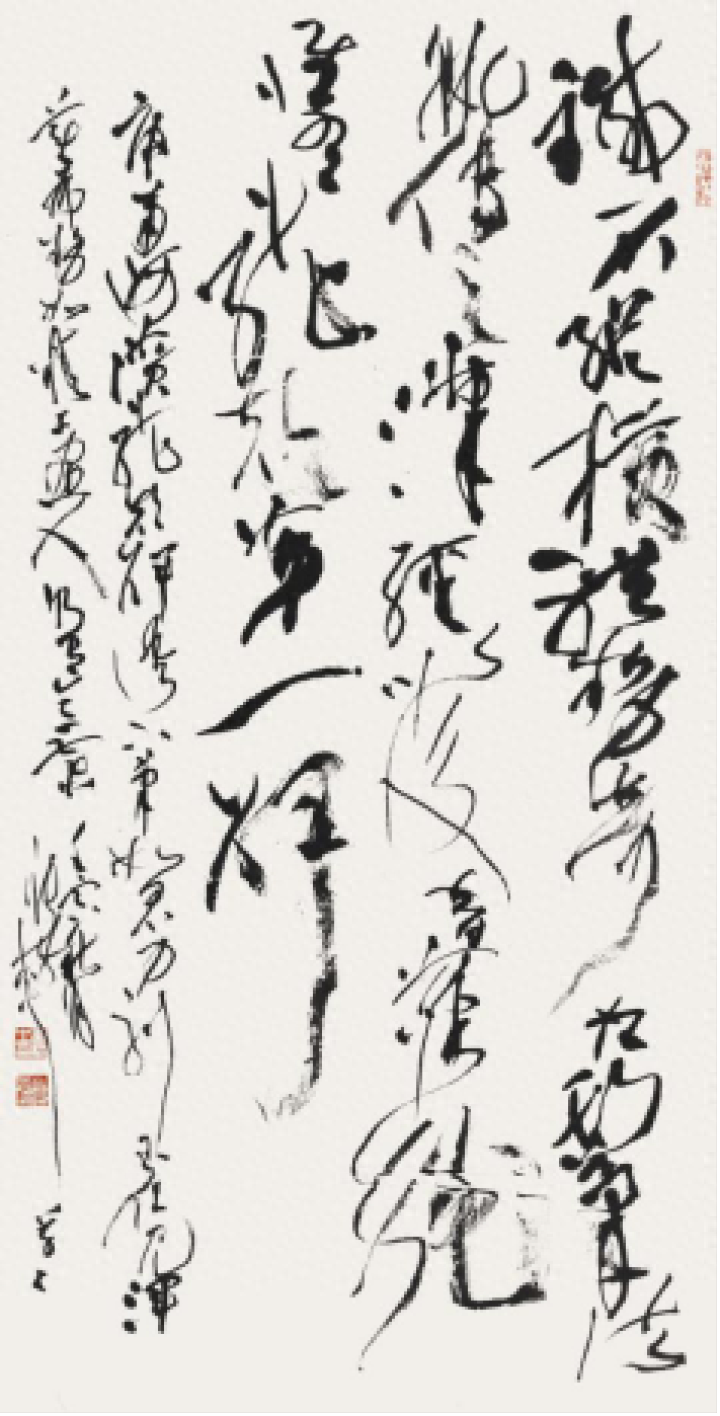
△ "The vertical and horizontal shapes of iron and stone are strange. Who can pass down Xiangsi's brushwork? After the Han Dynasty, there is no trace of it. Only the first stele of "Long Yan"." Kang Nanhai praised the "Cuan Long Yan stele" and said: "The painting is like a Kun Dao carving. The jade is pure and beautiful; the layout is like a finely crafted painting of a human being, but each one intentionally discards it. Renyin Autumn Moon, Tang Kai, 69×138cm.

△Poem "Climbing the Stork Tower" by Wang Zhihuan of Tang Dynasty, 34.5×138cm.
The calligraphy works "Roots of Quxue" and "Fan Cuan" are Professor Tang Kaizhi's lectures in Qujing in September 2021. He held three brushes on the paper at the same time, seeking innovation and change, freely opening and closing, and opening and closing freely. Written easily and naturally. The pen is used casually and freely without losing the rules and regulations, and the works show a rich sense of layering and writing rhythm. The technique of pen and ink can be applied freely, the lines and whites are natural and random, the wide areas can be moved, and the dense areas do not allow the needle to be inserted. The inscriptions and signatures in the works find gaps in the dense composition. They follow the situation and are ingenious, forming a strong contrast in density, thickness and size, which makes people suddenly feel enlightened and relaxed. Recalling the scene of writing and creating at that time, the talented people were gathered together, they were having fun, and they were still drunk, just like yesterday. Their true nature was fully revealed, and they felt more amiable and respectable.
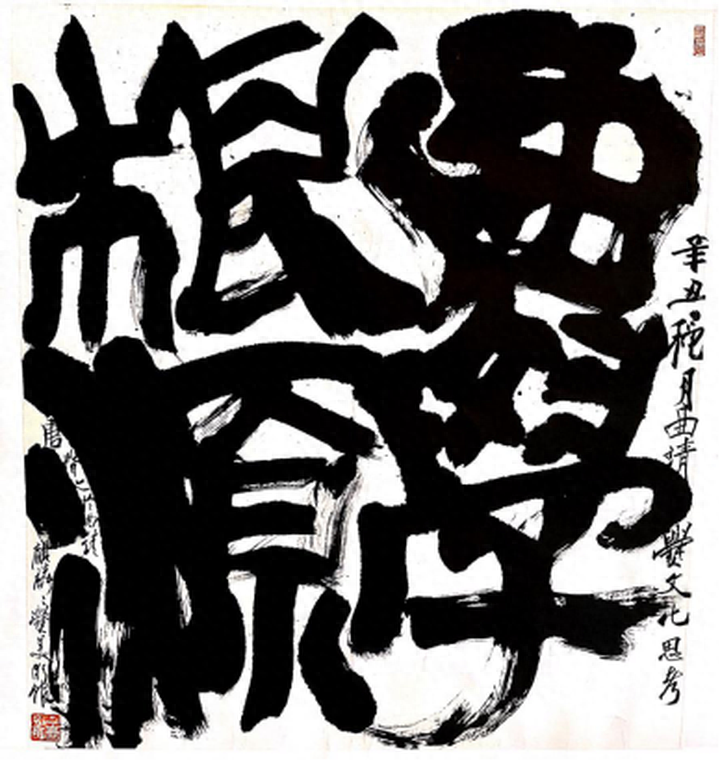
△"The Roots of Qu Xue" Xin Chou Qiu Yue Qu Jing Cuan Cultural Thoughts on Tang Kaiqi in Qujing Qilin Er Cuan Art Museum 97×90cm.
Looking at his works, reading his words, and listening to his explanations, I deeply feel the unique elegance and uprightness, natural freedom, easy-going, and humility of this artist who pursues excellence. The calligraphy works fully implement the concept of "reading calligraphy" advocated by the teacher Mr. Chen Zhenlian, while paying special attention to the formal beauty of calligraphy and the cultural and communication nature of the written content. Professor Tang Kaizhi is a master of academic calligraphy. In his calligraphy teaching, he advocates that calligraphy respects classics, pays attention to the inheritance of teachers, pays attention to systems and academic research, and has the courage to innovate and explore the future. In terms of creation, we pursue a clear classical path and sophisticated technical language, focus on cultivating the comprehensive ability of "five-body" creation, and shape the bookish and epigraphic style of professional academic taste in the style of our works.
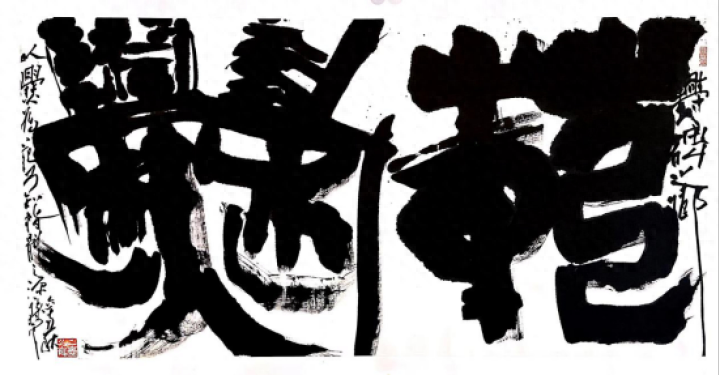
△"Fan Cuan" The hometown of Cuan Monument takes Cuan as Fan and knows the origin of regular script. Xinchou Qiuyue Tang Kai is 69×138cm.

△Tang Kairong's "One Floor" by Tang Kairong, Mr. Xin Chou Qiuyue Kaizhi's main stroke is 34.5×136cm.
The "Cuan Culture" calligraphy works created by Tang Kaizhi are unique, exquisite, wonderful, outstanding and completely new. Each work shows his admiration and admiration for the "Er Cuan Stele" and reflects his rigorous and meticulous scholarly attitude towards the art of calligraphy from another dimension. It will play a role in inheriting and promoting the "Cuan Culture". certain impetus. As a first-hand view, it is inevitable that there are still some unfinished ideas. I would like to share my encouragement with Mr. Tang Kaizhi and fellow readers.
(Main references, public accounts and media: "Calligraphy News", "Art China", "Rongbaozhai Online", "Gugel Art", "Tang Kaizhi and Dong Zeheng's Cuan Style Calligraphy Aesthetics", etc.)
Articles are uploaded by users and are for non-commercial browsing only. Posted by: Lomu, please indicate the source: https://www.daogebangong.com/en/articles/detail/tang-kai-zhi-cuan-wen-hua-shu-fa-zuo-pin-shang-xi-gun-fan-you-quan.html

 支付宝扫一扫
支付宝扫一扫 
评论列表(196条)
测试